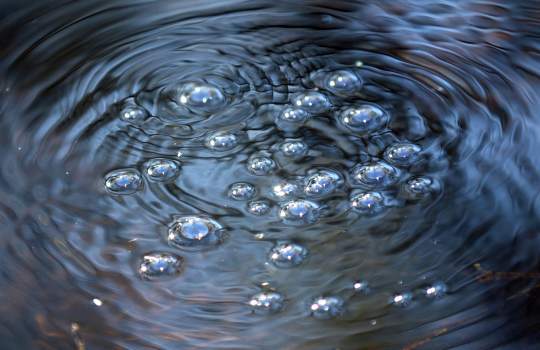Babbling brooks adding to climate change?

Methane bubbles rising to the surface of fresh water.
Studying stream bubbles isn’t exactly a walk in the park. What, with the mud and ticks, the long days hiking and swimming through mucky streams, the sun exposure and scratching brush.
But in the end, it may prove to be insightful. The bubbles coming from freshwater sources, new research suggests, may be a key and currently unaccounted for source of methane, the second-largest greenhouse gas contributor to human-driven global climate change.
In a May 16 paper published in the journal Global Change Biology, University of Wisconsin–Madison graduate student John Crawford and his colleagues, including his advisor Emily Stanley, a UW–Madison professor in the Department of Zoology and the Center for Limnology, show freshwater may be contributing more methane gas to the environment than has previously been measured.
The work has the potential to change how climate scientists and others determine the greenhouse gas budget. It also has implications for agricultural regions, where nitrogen and sulfur-based runoff may impact local methane production.
“There have been recent suggestions that freshwater streams, rivers and lakes are important sources of methane to the atmosphere,” says Crawford, who also works for the U.S. Geological Survey in Boulder, Colo.
In freshwater environments, methane gas comes from the metabolic byproducts of bacteria living in the organic-compound-rich, oxygen-poor sediments. Where oxygen, nitrogen or sulfur are high, methane is low because of the chemistry involved in its formation.
Wetlands are known sources of methane but the streams and rivers that drain them may also contribute to the overall methane budget. Just how much is little understood.
A bubble trap collecting freshwater bubbles from Allequash Creek.
Photo: Center for Limnology/John Crawford
Unlike carbon dioxide, which is highly soluble in water, methane exists in two forms in these freshwater sources: as a dissolved gas and encapsulated in bubbles that rise from sediments “like bubbles coming up in a can of soda,” says Crawford. Few studies have measured the methane trapped in those bubbles.
Crawford and the research team studied the methane in bubbles emitted from Allequash Creek, a tributary of Trout Lake in Vilas County, Wisconsin, where the creek bed is a mix of mucky, organic wetland components and sandy glacial sediment. They also looked at three other area creeks: Mann Creek, Stevenson Creek and North Creek.
To measure the methane in bubbles as they rose through the water, the team created traps to capture them and the air they contained. They ran the air through a sensor called a gas chromatograph to determine how much methane was contained within it. The team also looked at the rate of bubble release across sample sites.
They found there was as much methane in bubbles emitted from Allequash Creek and the surrounding area as has been measured in other wetland and lake environments. The researchers estimate at least 50 percent more methane can be emitted by bubbles in the region as is dissolved in the water.
“We are missing half the story, at least in this area, if we don’t include bubbles,” Crawford said. The team believes the creek is representative of other similar bodies of water in the Northern Highlands Lake District of Wisconsin.
A stretch of the Allequash Creek in the Northern Highlands Lake District of Wisconsin.
Photo: Center for Limnology/John Crawford
The study ran from May through November of 2013 and the team trudged out to the sampling sites every other day through that period, measuring bubble composition every other week.
They were surprised to find methane-containing bubbles coming from sandy sediments, which are generally less organic-rich than mucky beds. However, the concentration of the gas was lower from sandy sediments than from the mucky methane “hot spots.”
Crawford says it’s surprising to find methane at all in these highly-oxygenated creeks, though the methane is coming from mostly oxygen-poor sediments that form their beds.
While the new study cannot adequately assess the global contribution of bubble-contained methane from freshwater sources to the environment, it shows it’s an area worth further investigation. Methane can lead to ozone production and levels of the gas in the atmosphere are 150 percent higher than they were before the Industrial Revolution.
For Crawford, his interest lies in helping explain things that people can’t see, though that bubbles can be seen and felt makes the work more fun, he says. He is driven by the idea that really small ecosystems — like the freshwater lakes, streams and rivers Wisconsin is known for — can potentially play a major role in the overall greenhouse gas pool.
“You are never going to get the budget right if you don’t get all the pieces,” he says.
The study was funded by the National Science Foundation under Cooperative Agreement and by the U.S. Geological Survey Water, Energy and Biogeochemical Budgets Program.




